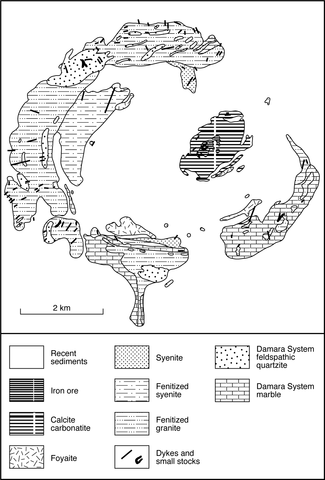stripes
A horseshoe-shaped range of low hills in flat country mark the Kalkfeld complex which has a diameter of about 5 km. The country rocks are Damara System marbles and feldspathic quartzites which have been invaded by biotite granite. Van Zijl (1962) considered the granite to be an integral part of the alkaline complex but Verwoerd (1967) argues that it is an earlier late Karoo granite. Inside the outer granite ring is a discontinuous ring of texturally heterogeneous syenite which in places is clearly fenitized but elsewhere consists almost wholly of perthite and a little quartz, titanite and zircon. This unit may be a product of fenitization of the granite. Within the syenites are scattered outcrops of foyaite and this rock type is thought to extend beneath the sandy flats that stretch to a central hill of carbonatite. The foyaites comprise perthite, which is generally fresh but in outcrops near the carbonatite replaced by natrolite, cancrinite, sericite and calcite, up to 30% nepheline, 0-15% sodalite, aegirine/aegirine-augite and variably abundant biotite. Eudialyte is found in the foyaites close to the carbonatite and other accessories include titanite, magnetite, chalcocite and pyrite. Verwoerd (1967) noted that the foyaites near to the carbonatite are chilled against it, and it appears that there are pre- and post-carbonatite foyaites. The central carbonatite plug covers 2.6 km2 but the outer contacts are not exposed. The carbonatite is sovite and flow layering is sometimes prominent defining a concentric, vertical structure. Accessories identified in the sovite include barite, monazite, albite, pyrochlore, pyrite, quartz, chlorite and magnetite, while apatite-rich sovite is distinguishable. Micaceous sovites occupy extensive areas and irregular patches and are banded rocks of alternating sovite and biotite-rich bands with appreciable pyrochlore, possible carbocernaite (Verwoerd, 1963), aegirine and sphalerite. An oxidised iron ore forms the highest part of the carbonatite plug and consists mainly of hematite, which pseudomorphs carbonate, and is traversed by up to 1 cm-wide veins of manganese ore. Tinguaite dykes are widespread. Fenitization of the granites is manifested typically by the replacement of quartz by aegirine-augite and alkali feldspar and development of turbidity in feldspar. Blocks of orthoclasite (>12% K2O) are present in the outer margins of the carbonatite. The chemical changes during fenitization are described by Prins (1981) who also gives whole rock analyses of the igneous rocks, as also do Van Zijl (1962) and Verwoerd (1967). Major and trace elements, including REE, on two carbonatites together with isotopic data for Rb, Sr, and Nd are given by Ziegler (1992) and le Roex and Lanyon (1998).
LE ROEX, A.P. and LANYON, R. 1998. Isotope and trace element geochemistry of Cretaceous Damaraland lamprophyres and carbonatites, northwestern Namibia: evidence for plume-lithosphere interactions. Journal of Petrology, 39: 1117-46.PRINS, P. 1981. The geochemical evolution of the alkaline and carbonatite complexes of the Damaraland igneous province, South West Africa. Annale Universiteit van Stellenbosch, Serie A1, Geologie, 3: 145-278.Van Zijl, 1962; VERWOERD, W.J. 1967. The carbonatites of South Africa and South West Africa. Handbook, Geological Survey of South Africa, 6: 1-452.ZIEGLER, U.R.F. 1992. Preliminary results of geochemistry, Sm-Nd and Rb-Sr studies of post-Karoo carbonatite complexes in southern Africa. Schweizerische Mineralogische und Petrographische Mitteilungen. Zurich, 72: 141-8.

